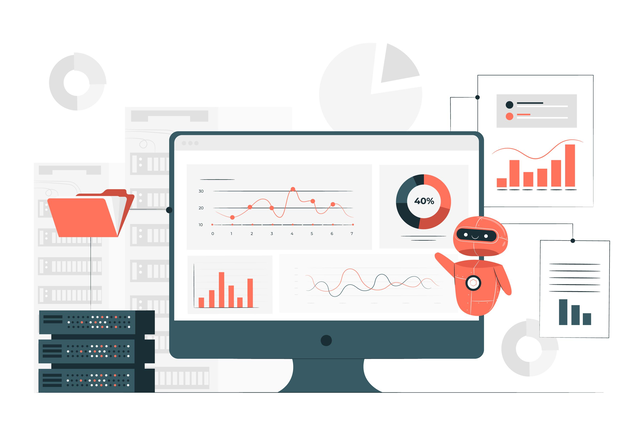In today’s fast-paced and data-driven world, businesses are constantly striving to stay ahead of the competition, and thus, data-driven decision-making has become a critical tool for businesses to make better, more informed decisions that can lead to increased efficiency, profitability, and growth. You can no longer rely solely on decisions based on your “gut” – especially when it is for major business improvements and/or changes!
In 2022, 92.1% of organizations report that they realize measurable business benefits, up from just 48.4% in 2017 and 70.3% in 2020 due to investments in Data and AI initiatives. – NewVantage Partners’ 2022 Data And AI Executive Survey
The challenge for companies today lies in making use of the vast amounts of data they have access to, and utilizing this data for informed decisions. Through data-driven decision-making, businesses can interpret this data and identify patterns and insights that can inform their strategy and decisions. Data-driven decision-making, in short, is a process that involves using data and analytics to inform business decisions.
In this article, we will explore the benefits of data-driven decision-making, steps to implement it, common mistakes to avoid, and real-world industry examples of successful data-driven practices. By the end of this article, you will have a better understanding of how data analytics can help businesses make better decisions and how you can implement data-driven practices in your organization.

Benefits of Data-Driven Decision Making
1. Increased accuracy and efficiency in decision-making:
One of the biggest benefits of data-driven decision-making is increased accuracy and efficiency in decision-making. Data provides businesses with insights into customer behavior, market trends, and operational performance, which can help identify opportunities and inform decision-making. With the right data and analytics tools, businesses can make informed decisions in real time, leading to increased accuracy and efficiency.
2. Better understanding of customer needs and preferences:
Data-driven decision-making can provide businesses with a better understanding of their customer’s needs and preferences. By analyzing customer data, businesses can identify patterns and trends that can inform marketing and product development strategies. This can help businesses to meet customer needs and preferences better, leading to increased customer satisfaction and loyalty.
3. Improved resource allocation and cost savings:
Data-driven decision-making can help businesses to allocate resources more efficiently, leading to cost savings. By analyzing operational data, businesses can identify areas of inefficiency and make adjustments to improve performance. This can help businesses to optimize their resources and reduce waste, leading to cost savings.
4. Enhanced risk management and mitigation:
Data-driven decision-making can help businesses to manage better and mitigate risk. By analyzing data, businesses can identify potential risks and take proactive measures to mitigate them. This can help businesses to avoid costly mistakes and minimize the impact of unforeseen events.
Steps to Implement Data-Driven Decision Making
Data-driven decision-making involves using data to inform business decisions and achieve better outcomes. To implement data-driven decision-making, there are certain steps that businesses need to follow. Following these five key steps, businesses can successfully implement data-driven decision-making and achieve better outcomes.
1. Define Business Objectives and Key Performance Indicators:
The first step is to clearly define your business objectives and identify the key performance indicators (KPIs) that will help you measure progress toward those objectives. This step involves understanding what you want to achieve and how you will measure success.
2. Identify Relevant Data Sources and Collect Data:
Once you have identified your business objectives and KPIs, you need to identify the relevant data sources that will provide the necessary data to measure progress toward those KPIs. This could include internal data sources such as sales data, customer data, and financial data, as well as external data sources such as market data and social media data.
3. Analyze and Interpret Data using Appropriate Tools and Techniques:
Once you have collected the relevant data, you need to analyze and interpret it using appropriate tools and techniques. This could include using statistical analysis, data visualization tools, and machine learning algorithms to uncover patterns and insights in the data.
4. Communicate Insights and Findings to Stakeholders:
Once you have analyzed the data and identified key insights and findings, it is important to communicate them to the relevant stakeholders in a clear and concise manner. This could involve creating reports, dashboards, or presentations that highlight the key findings and provide actionable recommendations.
5. Monitor and Evaluate Outcomes and Adjust Strategies Accordingly:
Finally, it is important to monitor and evaluate the outcomes of your data-driven decision-making efforts and adjust your strategies accordingly. This involves tracking progress toward your business objectives and KPIs, evaluating the effectiveness of your data-driven decisions, and making adjustments as needed to ensure continued success.
Common Mistakes to Avoid in Data-Driven Decision-Making
Data-driven decision-making can be an incredibly powerful tool for businesses looking to gain a competitive edge in today’s market. However, there are some common mistakes that can negatively impact the outcomes of these decisions. In this section, we’ll discuss some of the most common mistakes to avoid when implementing data-driven decision-making in your organization.
1. Overreliance on data without considering other factors:
One of the most common mistakes in data-driven decision-making is overreliance on data without considering other factors. While data can be incredibly useful in informing decisions, it is not the only factor to consider. It’s important to take into account factors such as customer feedback, market trends, and industry expertise. For example, imagine a retail company that relies solely on data to make decisions about which products to stock. While the data might suggest that a certain product is popular, if the company fails to take into account changing trends or customer feedback, it may end up with excess inventory that doesn’t sell.
2. Lack of data quality and consistency:
Another mistake to avoid is a lack of data quality and consistency. Without accurate and consistent data, it’s impossible to make informed decisions. It’s important to establish data quality standards and ensure that data is regularly audited and maintained. For example, imagine a healthcare provider that uses data to make decisions about patient care. If the data is inaccurate or inconsistent, the provider may make decisions that negatively impact patient outcomes.
3. Misinterpretation of data and faulty assumptions:
Misinterpretation of data and faulty assumptions can also lead to poor decision-making. It’s important to use appropriate data analysis techniques and to be aware of biases that may impact interpretations. For example, imagine a company that analyzes customer purchase data to inform decisions about which products to market. If they fail to consider that certain customers may be purchasing items as gifts, they may misinterpret the data and make decisions that don’t align with their customer base.
4. Failure to involve key stakeholders in the decision-making process:
Finally, a common mistake in data-driven decision-making is failing to involve key stakeholders in the decision-making process. It’s important to involve individuals with relevant expertise and perspectives to ensure that decisions are well-informed and align with organizational goals. For example, imagine a tech company that makes decisions about which products to develop without consulting with its sales team. The sales team may have valuable insights into customer needs and preferences that could impact product development decisions.

Real-World Industry Examples of Successful Data-Driven Decision Making
1. Amazon’s Personalized Product Recommendations
Amazon is a leader in e-commerce and a prime example of how data-driven decision-making can enhance the customer experience. Amazon collects data on each customer’s purchase history, search queries, and browsing behavior to provide personalized product recommendations. The company’s recommendation algorithm uses machine learning techniques to predict what products a customer is most likely to buy based on their past behavior and the behavior of similar customers.
By leveraging data to provide personalized recommendations, Amazon has significantly increased customer engagement and sales. In fact, according to a McKinsey report, 35% of Amazon’s revenue comes from its recommendation engine.
2. Netflix’s Content Curation and Production Decisions
Netflix has revolutionized the entertainment industry with its data-driven approach to content curation and production decisions. The company collects data on what its users are watching, when they are watching it, and how they are watching it. This data is used to create highly personalized recommendations and to inform the company’s content acquisition and production decisions.
For instance, the popular series, House of Cards, was commissioned by Netflix based on data insights that showed that users who enjoyed the original British version of the show were also fans of Kevin Spacey and director David Fincher. This data-driven decision resulted in a highly successful and critically acclaimed series.
3. Walmart’s Supply Chain Optimization
Walmart is known for its efficient supply chain management, and data analytics plays a critical role in its success. The company collects data on its inventory levels, sales trends, and customer demand to optimize its supply chain. By leveraging data insights, Walmart is able to ensure that the right products are in the right stores at the right time, minimizing waste and maximizing sales.
For instance, Walmart uses predictive analytics to determine which products are likely to sell out during a natural disaster, allowing the company to preposition those products in the affected areas. This data-driven approach has enabled Walmart to respond quickly to disasters and to provide essential supplies to customers in need.
4. Ford’s Predictive Maintenance and Quality Control
Ford is using data analytics to improve the quality and reliability of its vehicles. The company collects data on its vehicles’ performance, including engine diagnostics and sensor readings, to predict when maintenance will be required. This data-driven approach allows Ford to schedule maintenance proactively, reducing downtime for customers and increasing overall vehicle reliability.
In addition, Ford uses data analytics to identify quality issues early in the production process, enabling the company to make adjustments and prevent defects before they occur. By leveraging data to improve maintenance and quality control, Ford is able to provide a better customer experience and reduce warranty costs.
Conclusion
By leveraging the power of data analytics, companies can gain valuable insights into their customers, operations, and overall business performance. The benefits of this approach are clear, from increased accuracy and efficiency in decision-making to better customer understanding and cost savings.
However, it is important to note that implementing a successful data-driven strategy requires more than simply collecting and analyzing data. It also requires a willingness to adapt and continuously improve processes as new data and insights become available. This means identifying key performance indicators, gathering relevant data, analyzing it effectively, and communicating the findings to stakeholders.
By avoiding common mistakes and learning from real-world industry examples, businesses can reap the rewards of data-driven decision-making. With the ever-growing availability of data and the tools to analyze it, there has never been a better time for businesses to start leveraging the power of data.



